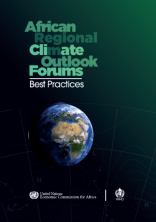African Regional Climate Outlook Forums Best Practices

Formally initiated at the Workshop on Reducing Climate-Related Vulnerability, held in October 1996 in Victoria Falls, Zimbabwe, the innovative WMO concept of regional climate outlook forums is now well established in Africa. There are now seven operational outlook forums in Africa coordinated by WMO-designated regional climate centres under each regional economic commission. The process of organizing an outlook forum includes a training session, a pre-forum, a forum and an outreach session. The differences in regional context, capacity and policy mean that there are likely to be variations in organization, funding mechanisms, consensus development, communication, dissemination and stakeholder engagement. It is thus crucial to highlight best practices to improve exchange between the various outlook forums and foster standardization of the process across the continent.
One of the most important best practices in organizing a regional climate outlook forum is the involvement of operational meteorologists, climatologists and researchers from national meteorological and hydrological services, and regional and international centres for the development of consensus products; media experts for communication and dissemination; and users from the main climate-sensitive socioeconomic sectors for decision-making. Moreover, the training session and the fact that it takes place before the forum itself is key for the acquisition, testing and assimilation of new methodologies and tools, the capacity-building of critical mass in national meteorological and hydrological services and the evaluation of the performance of the previous seasonal forecast regionally, based on ground truths provided by climate scientists from national meteorological and hydrological services. During the development phase, the good practices that lead to improved results and consolidate the consensusbased regional climate outlook are: verification of the products over specific areas with historical data sets, triggering further models and tools development; and the consideration of multi-models and/or multi-tools ensembles, rather than using a single method.